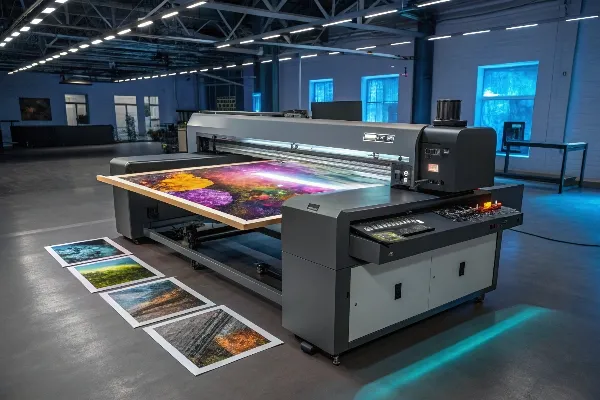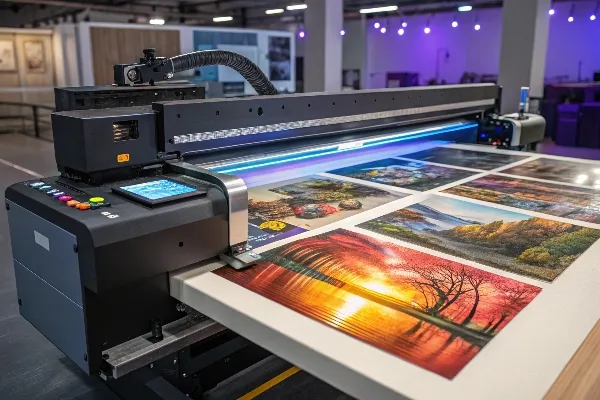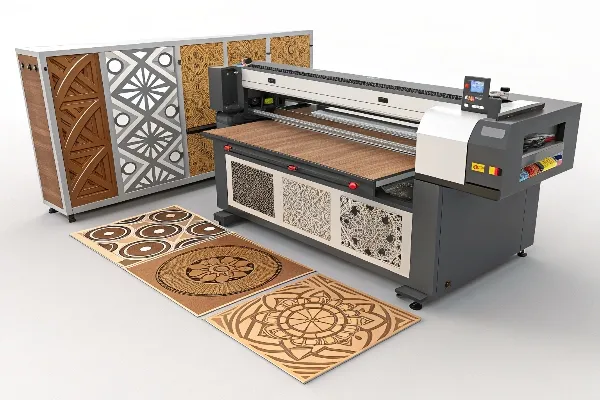Avoid your inquiry is delay response, please enter your WhatsApp/WeChat/Skype along with the message, so we can contact you at the very first time
We will reply you within 24 hours. If for urgent case, please add WhatsApp: +8617888313102, or WeChat: +86 17864107808. Or call +86 17864107808 directly.
*We respect your confidentiality and all information are protected. We will only use your information to respond to your inquiry and will never send unsolicited emails or promotional messages.
UV flatbed printers have revolutionized printing by offering versatility and high-quality results. But what makes them stand out from traditional printers?
UV flatbed printers use ultraviolet (UV) light to cure the ink instantly. This process allows printing on various materials like wood, glass, and metal, offering high durability and exceptional print quality.

UV printer in action
You might be wondering how UV flatbed printers compare to traditional ones. Let’s explore how they differ in terms of functionality and versatility.
If you’re used to regular printers, you may be curious about the differences. Are UV printers just a more expensive version, or do they truly offer something unique?
The key difference lies in the ink curing process. UV printers use UV light to dry ink instantly, allowing printing on a wide range of materials. Normal printers rely on heat and have fewer printing capabilities.

UV printer technology
UV printers are vastly different from standard printers. Normal printers typically use heat to dry ink on paper. However, UV printers use UV light to cure the ink instantly, meaning it doesn’t need heat to dry. This results in more vibrant and durable prints.
One of the major benefits of UV printers is their ability to print on non-traditional materials such as wood, metal, acrylic, and glass. This makes them ideal for industries like signage, packaging, and product customization. On the other hand, standard printers are limited to printing on paper or similar materials.
In terms of speed, UV printers often have an edge. The instant curing of ink means that the print can be touched or processed immediately after printing, unlike normal printers where you have to wait for the ink to dry. Furthermore, UV printers offer high-quality results with finer details and vivid colors, especially when printing on textured surfaces.
| Feature | UV Printer | Normal Printer |
|---|---|---|
| Ink drying process | UV light curing instantly | Heat drying over time |
| Material versatility | Can print on any material | Limited to paper/standard surfaces |
| Print quality | High resolution, vibrant colors | Basic color output |
| Speed | Faster, immediate results | Longer drying time |
A common question among those new to UV printing is how versatile these machines really are. Can they print on literally anything?
UV printers are highly versatile and can print on a wide range of materials including wood, glass, metal, ceramics, plastics, and even leather.

UV printer material versatility
UV printers can indeed print on an incredible variety of materials. Unlike traditional printers, which are confined to paper and a few other surfaces, UV flatbed printers use a flatbed design, which means they can handle objects of various shapes and sizes.
Some examples of materials that UV printers can handle include:
The ability to print on these materials opens up a world of possibilities for businesses in industries like promotional products, home décor, fashion, and packaging. Additionally, UV ink adheres well to non-porous materials, making it especially useful for printing on glossy or slick surfaces.
| Material Type | UV Printer Capability | Normal Printer Capability |
|---|---|---|
| Wood | Can print directly on wood | Limited or no capability |
| Glass | Can print on smooth glass | No capability |
| Metal | Prints directly on metal | No capability |
| Leather | Prints on leather | No capability |
With their advanced capabilities, you might be wondering about the price. Are UV printers really worth the investment, or are they simply too expensive for most businesses?
UV printers are generally more expensive than standard printers due to their advanced technology, but they offer better versatility and long-term savings in production efficiency.
UV printers are indeed more expensive upfront compared to traditional printers, primarily due to the technology involved. The UV curing system, higher build quality, and ability to print on a wide range of materials all contribute to the increased cost.
However, the benefits of UV printers often outweigh the initial expense. For one, they can eliminate the need for additional equipment or processes, like drying stations, since the ink cures instantly. This can lead to a faster turnaround time, reducing labor costs and improving overall efficiency. In industries where high-quality, custom prints on various materials are needed, the cost can quickly justify itself by increasing sales and opening up new revenue streams.
Moreover, UV printers are built to last longer than traditional printers, with fewer moving parts and less maintenance required. This translates to lower long-term maintenance costs and a higher return on investment over time.
| Printer Type | Initial Cost | Maintenance Cost | ROI Potential |
|---|---|---|---|
| UV Printer | High | Low | High |
| Normal Printer | Low | Moderate to High | Moderate |
Considering the higher cost of UV printers, it’s crucial to determine if they provide a solid return on investment. Are they worth the financial commitment?
UV printers can be an excellent investment for businesses looking to diversify their offerings and produce high-quality, durable prints on various materials.

UV printer investment
UV printers provide exceptional value for businesses that require high-quality prints1 on various materials. While the initial investment might seem steep, the flexibility and durability they offer make them worthwhile for many industries. For companies in sectors like packaging, promotional products, signage, and product customization, UV printers can open up new opportunities and allow businesses to diversify their product lines.
Moreover, because UV printing doesn’t require additional drying time or complex setups, it can greatly reduce production time and labor costs, making it more cost-efficient in the long run. Businesses can often complete more jobs in less time, thus increasing their profitability.
The versatility of UV printers2 also ensures that businesses can adapt to changing customer demands. Whether it’s creating custom gifts, personalized products, or intricate signage, UV printers offer the capability to meet those needs efficiently.
| Business Type | Investment Potential | Benefits |
|---|---|---|
| Packaging & Printing | High | Faster production, material versatility |
| Promotional Products | High | Customization opportunities |
| Signage | High | Durable prints on varied materials |
UV printers are a powerful tool for businesses looking to expand their product offerings and increase production efficiency. Despite the higher cost, their versatility and long-term savings make them a solid investment.